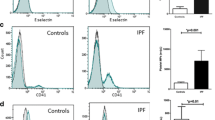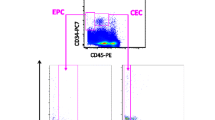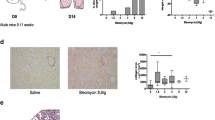Abstract
Introduction
Idiopathic pulmonary fibrosis (IPF) is a devastating disease characterized by obliteration of alveolar architecture, resulting in declining lung function and ultimately death. Pathogenic mechanisms involve a concomitant accumulation of scar tissue together with myofibroblasts activation and a strong abnormal vascular remodeling. Endothelial progenitor cells (ECFC subtype) have been investigated in several human lung diseases as a potential actor in IPF. We previously demonstrated that ECFCs are down-regulated in IPF in contrast to healthy controls. We postulated here that ECFCs might behave as a liquid biopsy in IPF patients and that they exert modified vasculogenic properties.
Methods and results
ECFCs isolated from controls and IPF patients expressed markers of the endothelial lineage and did not differ concerning adhesion, migration, and differentiation in vitro and in vivo. However, senescent and apoptotic states were increased in ECFCs from IPF patients as shown by galactosidase staining, p16 expression, and annexin-V staining. Furthermore, conditioned medium of IPF-ECFCs had increased level of interleukin-8 that induced migration of neutrophils in vitro and in vivo. In addition, an infiltration by neutrophils was shown in IPF lung biopsies and we found in a prospective clinical study that a high level of neutrophils in peripheral blood of IPF patients was associated to a poor prognosis.
Conclusion
To conclude, our study shows that IPF patients have a senescent ECFC phenotype associated with an increased IL-8 secretion potential that might contribute to lung neutrophils invasion during IPF.






Similar content being viewed by others
References
Lederer DJ, Martinez FJ (2018) Idiopathic pulmonary fibrosis. N Engl J Med 378:1811–1823. https://doi.org/10.1056/NEJMra1705751
Wolters PJ, Blackwell TS, Eickelberg O et al (2018) Time for a change: is idiopathic pulmonary fibrosis still idiopathic and only fibrotic? Lancet Respir Med 6:154–160. https://doi.org/10.1016/S2213-2600(18)30007-9
Hashimoto N, Phan SH, Imaizumi K et al (2010) Endothelial-mesenchymal transition in bleomycin-induced pulmonary fibrosis. Am J Respir Cell Mol Biol 43:161–172. https://doi.org/10.1165/rcmb.2009-0031OC
Kato S, Inui N, Hakamata A et al (2018) Changes in pulmonary endothelial cell properties during bleomycin-induced pulmonary fibrosis. Respir Res 19:127. https://doi.org/10.1186/s12931-018-0831-y
Ebina M, Shimizukawa M, Shibata N et al (2004) Heterogeneous increase in CD34-positive alveolar capillaries in idiopathic pulmonary fibrosis. Am J Respir Crit Care Med 169:1203–1208. https://doi.org/10.1164/rccm.200308-1111OC
Smadja DM, Mauge L, Nunes H et al (2013) Imbalance of circulating endothelial cells and progenitors in idiopathic pulmonary fibrosis. Angiogenesis 16:147–157. https://doi.org/10.1007/s10456-012-9306-9
Strieter RM, Gomperts BN, Keane MP (2007) The role of CXC chemokines in pulmonary fibrosis. J Clin Invest 117:549–556. https://doi.org/10.1172/JCI30562
Smadja DM, Nunes H, Juvin K et al (2014) Increase in both angiogenic and angiostatic mediators in patients with idiopathic pulmonary fibrosis. Pathol Biol 62:391–394. https://doi.org/10.1016/j.patbio.2014.07.006
Silvestre J-S, Smadja DM, Lévy BI (2013) Postischemic revascularization: from cellular and molecular mechanisms to clinical applications. Physiol Rev 93:1743–1802. https://doi.org/10.1152/physrev.00006.2013
d’Audigier C, Susen S, Blandinieres A et al (2018) Egfl7 represses the vasculogenic potential of human endothelial progenitor cells. Stem Cell Rev Rep 14:82–91. https://doi.org/10.1007/s12015-017-9775-8
Basile DP, Yoder MC (2014) Circulating and tissue resident endothelial progenitor cells. J Cell Physiol 229:10–16. https://doi.org/10.1002/jcp.24423
Toshner M, Voswinckel R, Southwood M et al (2009) Evidence of dysfunction of endothelial progenitors in pulmonary arterial hypertension. Am J Respir Crit Care Med 180:780–787. https://doi.org/10.1164/rccm.200810-1662OC
Baker CD, Balasubramaniam V, Mourani PM et al (2012) Cord blood angiogenic progenitor cells are decreased in bronchopulmonary dysplasia. Eur Respir J 40:1516–1522. https://doi.org/10.1183/09031936.00017312
Paschalaki KE, Starke RD, Hu Y et al (2013) Dysfunction of endothelial progenitor cells from smokers and chronic obstructive pulmonary disease patients due to increased DNA damage and senescence. Stem Cells Dayt Ohio 31:2813–2826. https://doi.org/10.1002/stem.1488
Fadini GP, Schiavon M, Rea F et al (2007) Depletion of endothelial progenitor cells may link pulmonary fibrosis and pulmonary hypertension. Am J Respir Crit Care Med 176:724–725. https://doi.org/10.1164/ajrccm.176.7.724a author reply 725.
Díez M, Musri MM, Ferrer E et al (2010) Endothelial progenitor cells undergo an endothelial-to-mesenchymal transition-like process mediated by TGFbetaRI. Cardiovasc Res 88:502–511. https://doi.org/10.1093/cvr/cvq236
Raghu G, Collard HR, Egan JJ et al (2011) An official ATS/ERS/JRS/ALAT statement: idiopathic pulmonary fibrosis: evidence-based guidelines for diagnosis and management. Am J Respir Crit Care Med 183:788–824. https://doi.org/10.1164/rccm.2009-040GL
Mauge L, Sabatier F, Boutouyrie P et al (2014) Forearm ischemia decreases endothelial colony-forming cell angiogenic potential. Cytotherapy 16:213–224. https://doi.org/10.1016/j.jcyt.2013.09.007
Bacha NC, Blandinieres A, Rossi E et al (2018) Endothelial Microparticles are Associated to Pathogenesis of Idiopathic Pulmonary Fibrosis. Stem Cell Rev 14:223–235. https://doi.org/10.1007/s12015-017-9778-5
Arnulf B, Lecourt S, Soulier J et al (2007) Phenotypic and functional characterization of bone marrow mesenchymal stem cells derived from patients with multiple myeloma. Leukemia 21:158–163. https://doi.org/10.1038/sj.leu.2404466
Smadja DM, Bièche I, Helley D et al (2007) Increased VEGFR2 expression during human late endothelial progenitor cells expansion enhances in vitro angiogenesis with up-regulation of integrin alpha(6). J Cell Mol Med 11:1149–1161. https://doi.org/10.1111/j.1582-4934.2007.00090.x
Nakatsu MN, Sainson RCA, Aoto JN et al (2003) Angiogenic sprouting and capillary lumen formation modeled by human umbilical vein endothelial cells (HUVEC) in fibrin gels: the role of fibroblasts and Angiopoietin-1. Microvasc Res 66:102–112
Eglinger J, Karsjens H, Lammert E (2017) Quantitative assessment of angiogenesis and pericyte coverage in human cell-derived vascular sprouts. Inflamm Regen 37:2. https://doi.org/10.1186/s41232-016-0033-2
Smadja D, Gaussem P, Roncal C et al (2010) Arterial and venous thrombosis is associated with different angiogenic cytokine patterns in patients with antiphospholipid syndrome. Lupus 19:837–843. https://doi.org/10.1177/0961203309360985
Ferratge S, Ha G, Carpentier G et al (2017) Initial clonogenic potential of human endothelial progenitor cells is predictive of their further properties and establishes a functional hierarchy related to immaturity. Stem Cell Res 21:148–159. https://doi.org/10.1016/j.scr.2017.04.009
Coppé J-P, Desprez P-Y, Krtolica A, Campisi J (2010) The senescence-associated secretory phenotype: the dark side of tumor suppression. Annu Rev Pathol 5:99–118. https://doi.org/10.1146/annurev-pathol-121808-102144
Melero-Martin JM, De Obaldia ME, Allen P et al (2010) Host myeloid cells are necessary for creating bioengineered human vascular networks in vivo. Tissue Eng Part A 16:2457–2466. https://doi.org/10.1089/ten.TEA.2010.0024
Lin R-Z, Lee CN, Moreno-Luna R et al (2017) Host non-inflammatory neutrophils mediate the engraftment of bioengineered vascular networks. Nat Biomed Eng 1: 0081. https://doi.org/10.1038/s41551-017-0081
Yin Q, Nan H-Y, Zhang W-H et al (2011) Pulmonary microvascular endothelial cells from bleomycin-induced rats promote the transformation and collagen synthesis of fibroblasts. J Cell Physiol 226:2091–2102. https://doi.org/10.1002/jcp.22545
Pantel K, Alix-Panabières C (2016) Functional studies on viable circulating tumor cells. Clin Chem 62:328–334. https://doi.org/10.1373/clinchem.2015.242537
Vassallo PF, Simoncini S, Ligi I et al (2014) Accelerated senescence of cord blood endothelial progenitor cells in premature neonates is driven by SIRT1 decreased expression. Blood 123:2116–2126. https://doi.org/10.1182/blood-2013-02-484956
Selman M, Pardo A (2014) Revealing the pathogenic and aging-related mechanisms of the enigmatic idiopathic pulmonary fibrosis. An integral model. Am J Respir Crit Care Med 189:1161–1172. https://doi.org/10.1164/rccm.201312-2221PP
Medina RJ, O’Neill CL, O’Doherty TM et al (2013) Ex vivo expansion of human outgrowth endothelial cells leads to IL-8-mediated replicative senescence and impaired Vasoreparative function: IL8 mediates OEC senescence. STEM CELLS 31:1657–1668. https://doi.org/10.1002/stem.1414
Ingram DA (2004) Identification of a novel hierarchy of endothelial progenitor cells using human peripheral and umbilical cord blood. Blood 104:2752–2760. https://doi.org/10.1182/blood-2004-04-1396
Kimura T, Kohno H, Matsuoka Y et al (2011) CXCL8 enhances the angiogenic activity of umbilical cord blood-derived outgrowth endothelial cells in vitro. Cell Biol Int 35:201–208. https://doi.org/10.1042/CBI20090225
Smadja DM, Bièche I, Susen S et al (2009) Interleukin 8 is differently expressed and modulated by PAR-1 activation in early and late endothelial progenitor cells. J Cell Mol Med 13:2534–2546. https://doi.org/10.1111/j.1582-4934.2008.00429.x
Carré PC, Mortenson RL, King TE et al (1991) Increased expression of the interleukin-8 gene by alveolar macrophages in idiopathic pulmonary fibrosis. A potential mechanism for the recruitment and activation of neutrophils in lung fibrosis. J Clin Invest 88:1802–1810. https://doi.org/10.1172/JCI115501
Keane MP, Belperio JA, Moore TA et al (1999) Neutralization of the CXC chemokine, macrophage inflammatory protein-2, attenuates bleomycin-induced pulmonary fibrosis. J Immunol 1950 162:5511–5518
Richter AG, Perkins GD, Chavda A et al (2011) Neutrophil chemotaxis in granulomatosis with polyangiitis (Wegener’s) and idiopathic pulmonary fibrosis. Eur Respir J 38:1081–1088. https://doi.org/10.1183/09031936.00161910
Richards TJ, Kaminski N, Baribaud F et al (2012) Peripheral blood proteins predict mortality in idiopathic pulmonary fibrosis. Am J Respir Crit Care Med 185:67–76. https://doi.org/10.1164/rccm.201101-0058OC
Fujimori Y, Kataoka M, Tada S et al (2003) The role of Interleukin-8 in interstitial pneumonia. Respirology 8:33–40
Ahn M-H, Park B-L, Lee S-H et al (2011) A promoter SNP rs4073T> A in the common allele of the interleukin 8 gene is associated with the development of idiopathic pulmonary fibrosis via the IL-8 protein enhancing mode. Respir Res 12:73
Raghu G, Rochwerg B, Zhang Y et al (2015) An official ATS/ERS/JRS/alat clinical practice guideline: treatment of idiopathic pulmonary fibrosis. An update of the 2011 clinical practice guideline. Am J Respir Crit Care Med 192:e3–e19. https://doi.org/10.1164/rccm.201506-1063ST
Desai O, Winkler J, Minasyan M, Herzog EL (2018) The role of immune and inflammatory cells in idiopathic pulmonary fibrosis. Front Med 5:. https://doi.org/10.3389/fmed.2018.00043
Chua F, Dunsmore SE, Clingen PH et al (2007) Mice lacking neutrophil elastase are resistant to bleomycin-induced pulmonary fibrosis. Am J Pathol 170:65–74. https://doi.org/10.2353/ajpath.2007.060352
Takemasa A, Ishii Y, Fukuda T (2012) A neutrophil elastase inhibitor prevents bleomycin-induced pulmonary fibrosis in mice. Eur Respir J 40:1475–1482. https://doi.org/10.1183/09031936.00127011
Gregory AD, Kliment CR, Metz HE et al (2015) Neutrophil elastase promotes myofibroblast differentiation in lung fibrosis. J Leukoc Biol 98:143–152. https://doi.org/10.1189/jlb.3HI1014-493R
Henry MT, McMahon K, Mackarel AJ et al (2002) Matrix metalloproteinases and tissue inhibitor of metalloproteinase-1 in sarcoidosis and IPF. Eur Respir J 20:1220–1227
Corbel M, Caulet-Maugendre S, Germain N et al (2001) Inhibition of bleomycin-induced pulmonary fibrosis in mice by the matrix metalloproteinase inhibitor batimastat. J Pathol 193:538–545. https://doi.org/10.1002/path.826
Chrysanthopoulou A, Mitroulis I, Apostolidou E et al (2014) Neutrophil extracellular traps promote differentiation and function of fibroblasts. J Pathol 233:294–307. https://doi.org/10.1002/path.4359
Acknowledgements
We thank the animal Platform, CRP2 – UMS 3612 CNRS – US25 Inserm-IRD – Faculté de Pharmacie de Paris, Université Paris Descartes, Paris, France. We are indebted to cell therapy department of Saint-Louis Hospital (AP-HP, Paris) for cord-blood samples. This work was supported by grants of the Chancellerie des Universités (Legs Poix), PRES, and PROMEX STIFTUNG FUR DIE FORSCHUNG foundation. A. Blandinières was supported by grants from AP-HP and INSERM (contrat d’accueil).
Author information
Authors and Affiliations
Corresponding author
Ethics declarations
Conflict of interest
The authors do not have any conflicts of interest to disclose.
Additional information
Publisher’s Note
Springer Nature remains neutral with regard to jurisdictional claims in published maps and institutional affiliations.
Electronic supplementary material
Below is the link to the electronic supplementary material.
Rights and permissions
About this article
Cite this article
Blandinières, A., Gendron, N., Bacha, N. et al. Interleukin-8 release by endothelial colony-forming cells isolated from idiopathic pulmonary fibrosis patients might contribute to their pathogenicity. Angiogenesis 22, 325–339 (2019). https://doi.org/10.1007/s10456-018-09659-5
Received:
Accepted:
Published:
Issue Date:
DOI: https://doi.org/10.1007/s10456-018-09659-5




